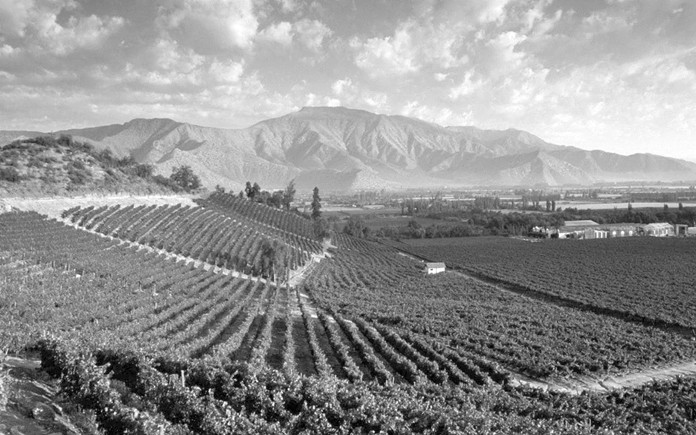
In recent months, several bargain-basement Chilean wines have started to appear, giving locally-produced fruit wines a run for their money. There’s a good selection at Big C in South Pattaya where they offer several wines well under Bt 400, most of which were produced and bottled by the same Chilean company. They can often be recognized by their outlandish names.
Please Support Pattaya Mail
The long, thin country of Chile is confined between the Andes Mountains to the east and the Pacific Ocean to the west. Its vineyards lie along an 800-mile stretch of land that has a temperate climate similar to that of California. You might be surprised to know that they’ve been growing vines in Chile since the sixteenth century, after the country was colonized (or invaded, if you prefer) by the Spanish around 1554. You’d have thought that the Spanish would have encouraged the locals to develop their own wine industry. But no such luck. During Spanish rule, Chilean vineyards were restricted in production and the Chileans were instructed to buy all their wine from Spain. To their credit, most of them didn’t because they preferred their own wine. In any case, after a rough voyage across the Atlantic, much of the Spanish wine would probably be oxidized and barely drinkable. In 1641, in the true spirit of imperial colonialism, the mean-minded Spanish banned Chile from exporting its wine, but this unfair ruling was also largely ignored.
The disastrous appearance of the phylloxera epidemic in mid-19th century Europe brought an unexpected bonus to the Chilean wine industry. With countless French vineyards in ruin, many wine makers moved to South America bringing their experience and techniques with them. As a result, the history of wine making in Chile was largely influenced by the French, especially the wine-making traditions of Bordeaux. Even so, during the first half of the 20th century, Chilean wine was considered rather low quality but substantial foreign investment and technical advances had an enormous impact with the result that by the end of the 20th century, Chile was producing some world-class wines.
Quincho Dry White (Chile) Bt 345 @ Big C
They don’t come much cheaper than this, an entry-level wine produced and bottled in Chile. In case you’re wondering, quincho (KEEN-cho) is the Spanish word for barbecue. There’s a picture of one on the back label, which also contains the mystifying expression “Secret Dry White” though what the secret is I have yet to discover.
The wine is a pale straw colour with an attractive fruity aroma of honey, pomelo and dusty pineapple, if you can imagine dusty pineapple. The wine smells more expensive than it actually is and if someone gave me a glass of this to taste, on the aroma alone I’d estimate the price to be around Bt 700. And yet, I often see people trying a wine for the first time and not bothering to sniff it first. It seems such a dreadful omission.
There’s much more fruit on the palate than I expected, dominated by honey and pineapple. The taste blooms in the mouth too, something you wouldn’t normally expect with a wine at this price. It’s quite a dry wine, though the dryness is offset by generous fruit. The acidity is quite low too and at just 11.5% ABV this wine could be enjoyed on its own.
Quincho Dry Red (Chile) Bt 345 @ Big C
To my surprise, this bottle was closed with a cork, albeit a synthetic one. Nearly all wine bottles these days are sealed with the so-called Stelvin closure which is the fancy name for the familiar screw-cap. The cork was rather reticent too, and I had to ferret out my strong twin-lever bottle opener which can deal with the most stubborn corks. I doubt whether a simple cork screw would stand much of a chance.
This entry-level wine is a rich dark red with a distinctive purple hue. It has an aroma of plums and jammy fruit yet the body is quite light with plenty of tannin. I know that many people prefer loads of fruit on the palate but sometimes less is more, especially if you plan to drink this wine with food. And I hope you do, because to my mind this is a “food wine”, even if the food happens to be bread and cheese or a humble beef burger. It’s distinctively dry and the style slightly reminds me of simple Bordeaux, the sort that the French buy every day in large plastic bottles.
This wine is significantly cheaper than Mont Clair, the work-horse wine of almost every bar in town and I thought it might be interesting to compare them. The wines I mean, not the bars. The Quincho smells vaguely French whereas the Mont Clair smells like, well, Mont Clair. The Quincho feels firm, dry and slightly austere whereas the Mont Clair is slightly fuller, a little less dry and blended for smoothness. Other than that, there’s not a great deal of difference between them except fifty baht. And fifty baht is fifty baht.
 |
 |
 |





